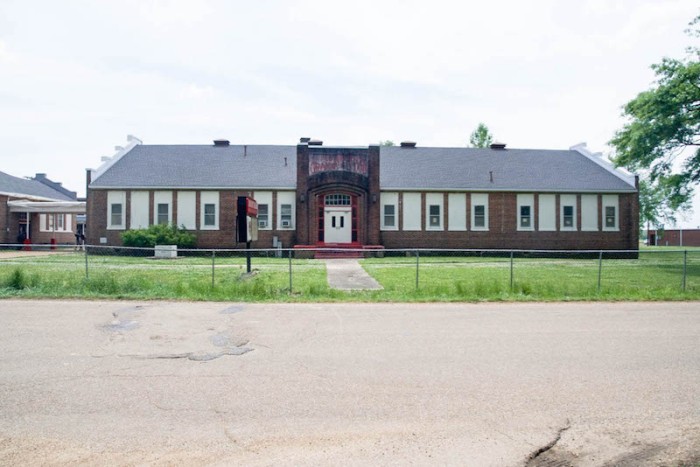
Itta Bena citizens met in May 1939 to discuss the proposed new elementary school building.
The old Itta Bena school building is being wrecked, preparatory to the building of a new school building to serve that community. (Greenwood Commonwealth, 12 Sep 1939, p. 1)
It is not clear which former school building was facing demolition, as in 1941 after the opening of the new elementary school, there was a drive to “convert the old Itta Bena Grammar School into a community center” (Greenwood Commonwealth, Mar 21, 1941). That seems to indicate that the old high school which was converted to use by the grammar school was not the building demolished, or that demolition plans were revised. Architect Robert James Moor designed the new grammar school, constructed in 1940 by the National Youth Administration. Dedicated February 24, 1941, the $45,000 building encumbered a cost of approximately $25,000 to Itta Bena. The dedication was held in the 1930 high school auditorium, with George M. Deen of the Greenwood District of NYA present.
The tour of the new school building declared it
…adequate to meet the needs for years to come. (Greenwood Commonwealth, 24 Feb 1941)
Apparently that prediction was true, as the school remains in use in 2018. Gatlin and Tietz (2009, NRHP nomination) described the building as
- one-story brick, five course common bond, with two parapeted gables with concrete caps
- main entrance framed by pilasters rising above the roofline joined by a plain parapet
- entrance recessed within the deep segmented arch
- one panel sidelights topped by a segmented tri-part multi light transom.
Unfortunately for the appearance, the “unsympathetic remodel” of windows visually altered the building’s lines. But, what about the 1930 high school building next door? Greenwood’s Frank R. McGeoy designed the new high school building, dedicated November 20, 1930. Other contracts awarded went to A. M. Allen or Moorhead for $33,940, Davis Plumbing of Jackson, A. M. Borsch of Greenwood for wiring, and Paine Plumbing and Heating of Jackson. The new building was described as “a $50,000 one-story brick building with all modern conveniences and has an auditorium with a seating capacity of 500” (High School is Beautiful Structure, Greenwood Commonwealth, Nov. 21, 1930, p. 1). The addition of the new high school gave Itta Bena the second of two brick school buildings. McGeoy’s proposed design included ten class rooms, study hall, laboratories for science, typewriting and commercial course instruction rooms, music rooms, and the 500-seat auditorium. The old high school was planned to be used as the grammar school.
Greenwood’s Frank R. McGeoy designed the new high school building, dedicated November 20, 1930. Other contracts awarded went to A. M. Allen or Moorhead for $33,940, Davis Plumbing of Jackson, A. M. Borsch of Greenwood for wiring, and Paine Plumbing and Heating of Jackson. The new building was described as “a $50,000 one-story brick building with all modern conveniences and has an auditorium with a seating capacity of 500” (High School is Beautiful Structure, Greenwood Commonwealth, Nov. 21, 1930, p. 1). The addition of the new high school gave Itta Bena the second of two brick school buildings. McGeoy’s proposed design included ten class rooms, study hall, laboratories for science, typewriting and commercial course instruction rooms, music rooms, and the 500-seat auditorium. The old high school was planned to be used as the grammar school.
At the meeting of the Itta Bena school board, W. G. Eckles, the state director of school building service recommended an “unusual design” (State Director Reports School Building Active, Clarion-Ledger, Jan. 10, 1930, p. 16).
Due to limitations in space, the building will mark a deviation from the popular “E” type building. Instead of setting the auditorium inside the court yard, it will be placed at the front, projecting ahead of the building proper. Side entrances will be available to students, while the front entrance will serve the auditorium.
The Google map view of the school looks like the popular T-plan used from 1913-1950s (Baughn, J. V. O. 2012. A modern school plant: Rural consolidated schools in Mississippi, 1910-1955. Buildings & Landscapes: Journal of the Vernacular Architecture Forum, 19(1), 43-72). However, the T-plan featured the auditorium at the rear of the school, rather than at the front. The L-plan featured a projecting auditorium at the front but was not used in Mississippi until 1936 (Baughn).
Moor’s design for the 1940 elementary school reflected comparable design elements of the high school.
Categories: Delta, Historic Preservation, Itta Bena, New Deal, Schools







That’s an interesting comment by W.G. Eckles about the E-plan, but you’re right, this is a T-plan, and I’ll have to check my notes to be sure, but I’m pretty sure that the rear wing is the auditorium. An E-plan building would have been much larger–Jackson’s Central High School building is an E-plan–and maybe it was too ambitious for Itta Bena in 1930, so they ended up building two smaller buildings 10 years apart. Given that the stock market had just crashed a few months before Eckles made his remarks, maybe as the year went on, the effects of the Depression became clear and they scaled the design back to meet the budget.
LikeLiked by 1 person
Thank you for clearing that up! I have used your article as a reference many times.
LikeLike